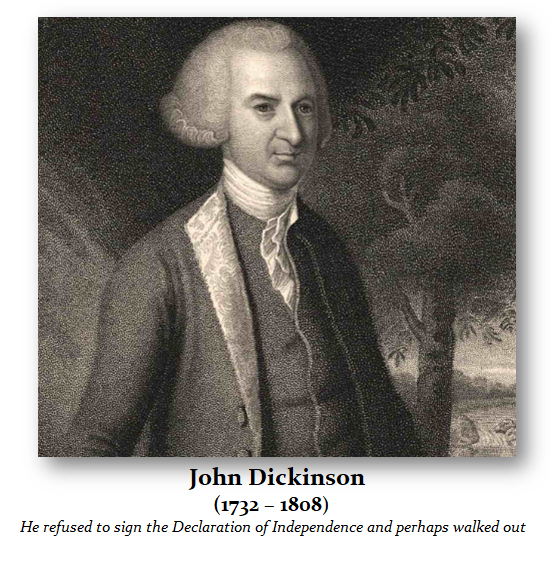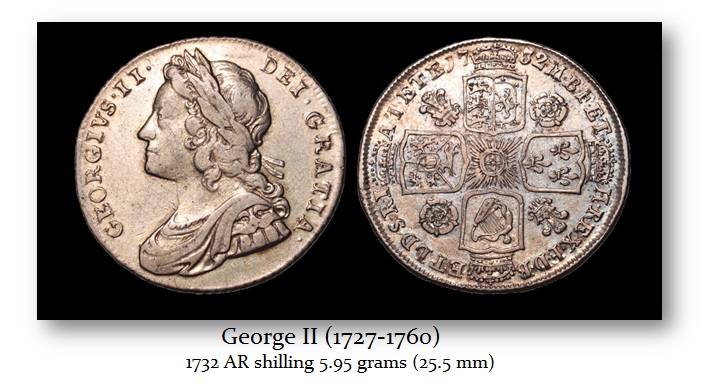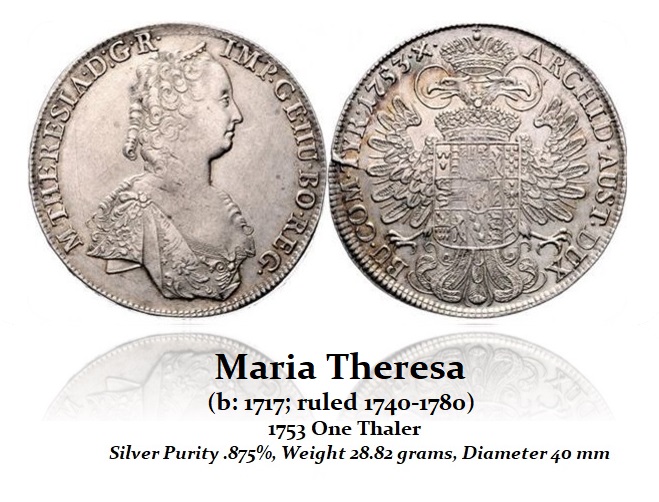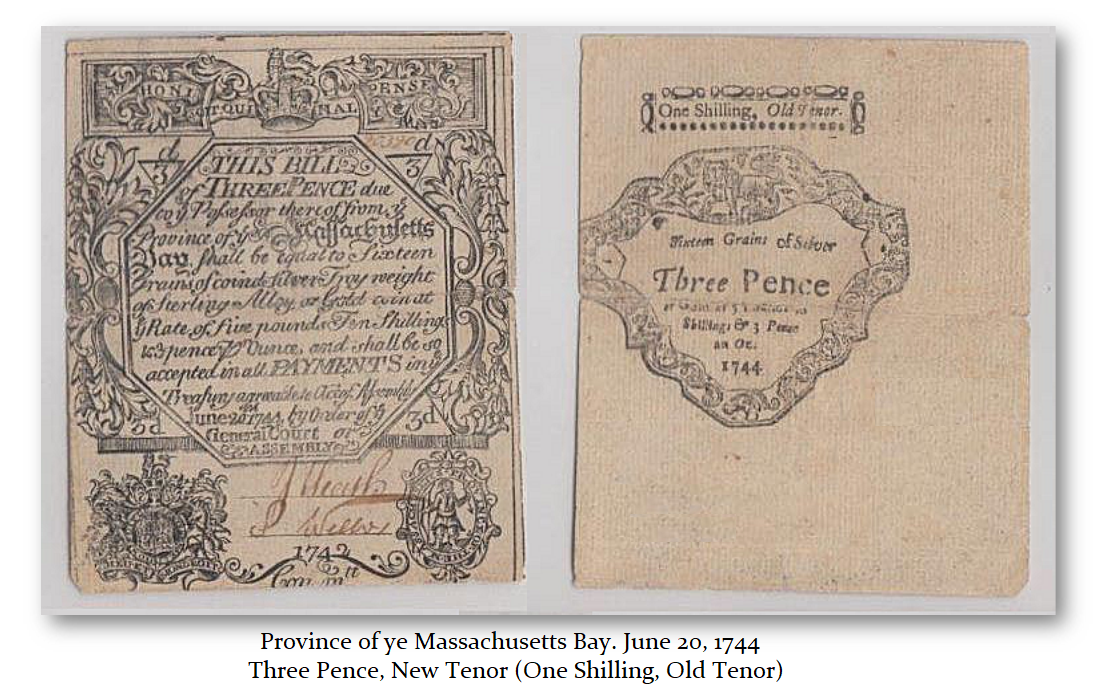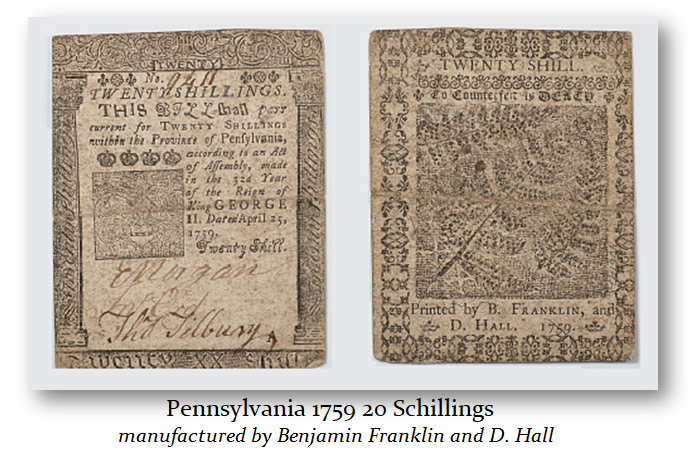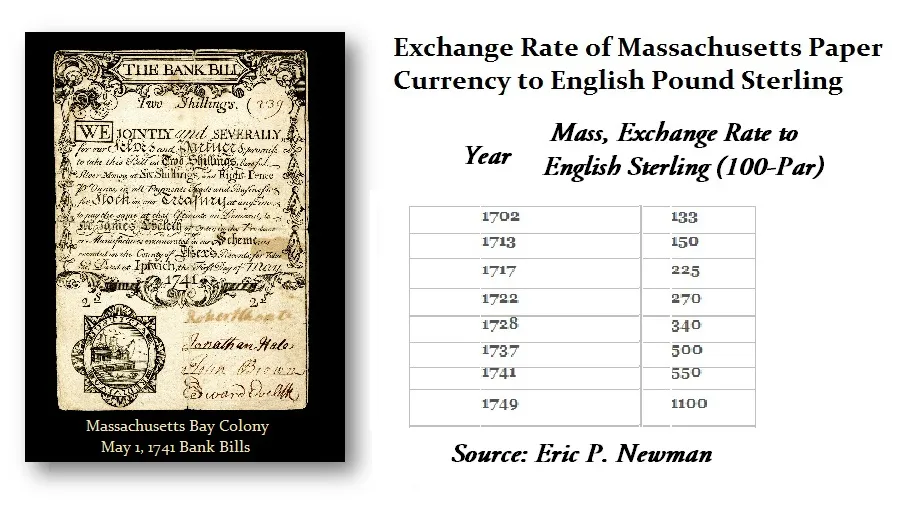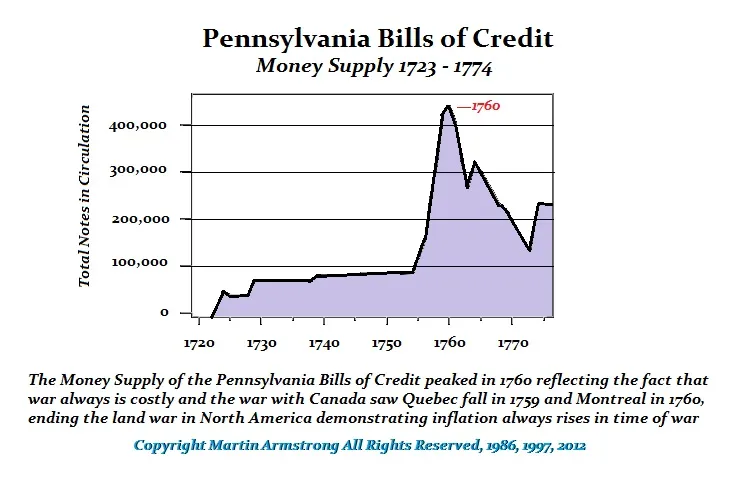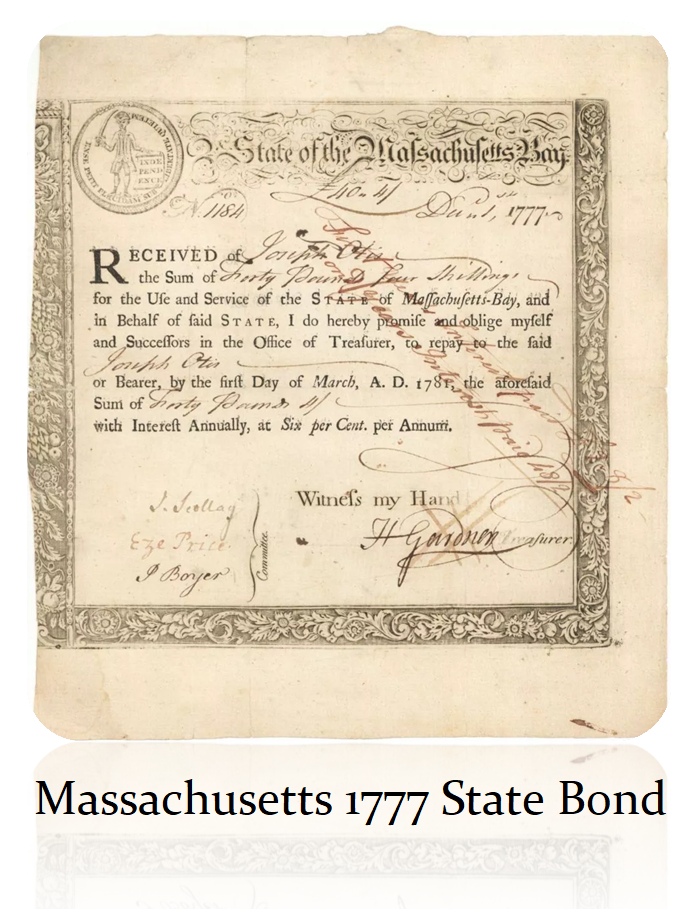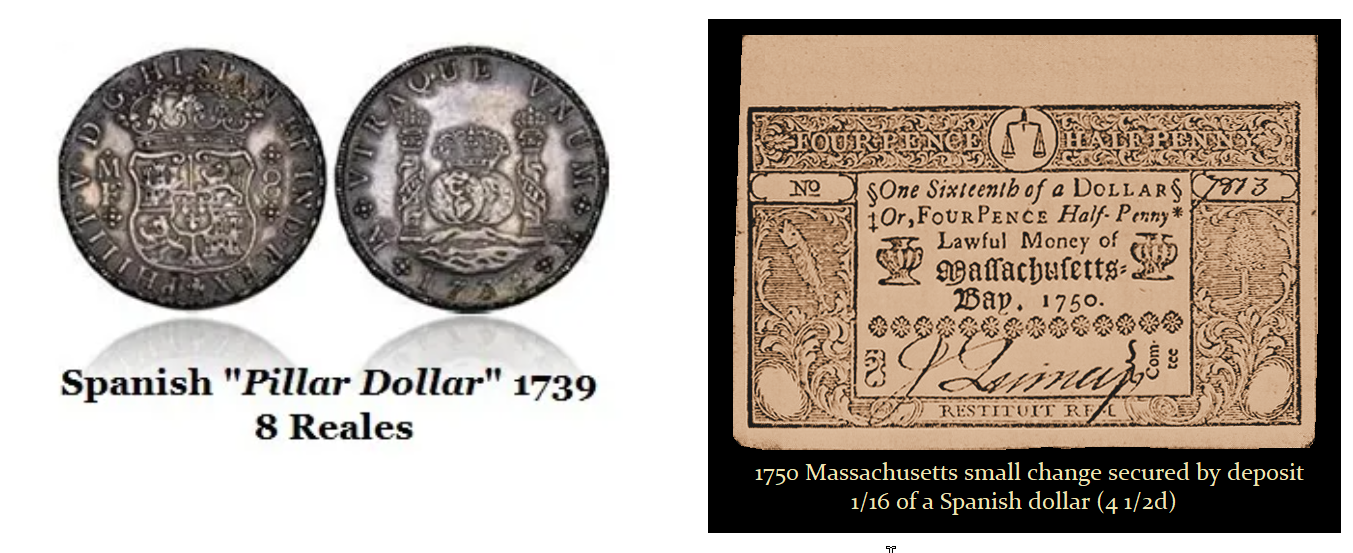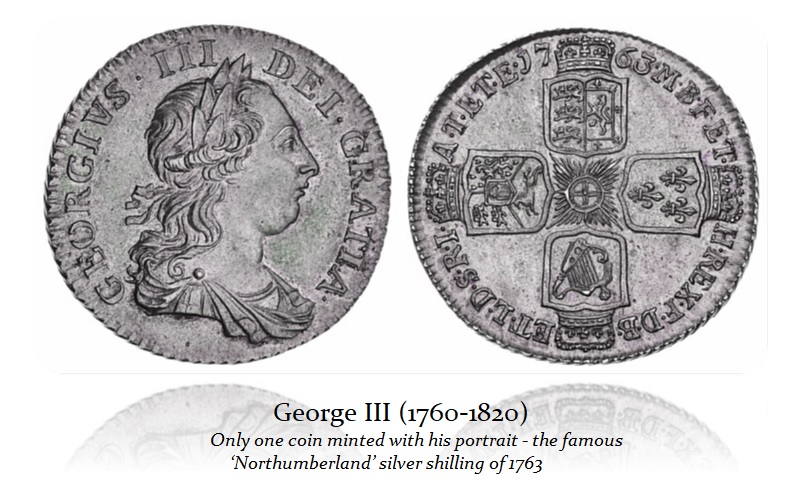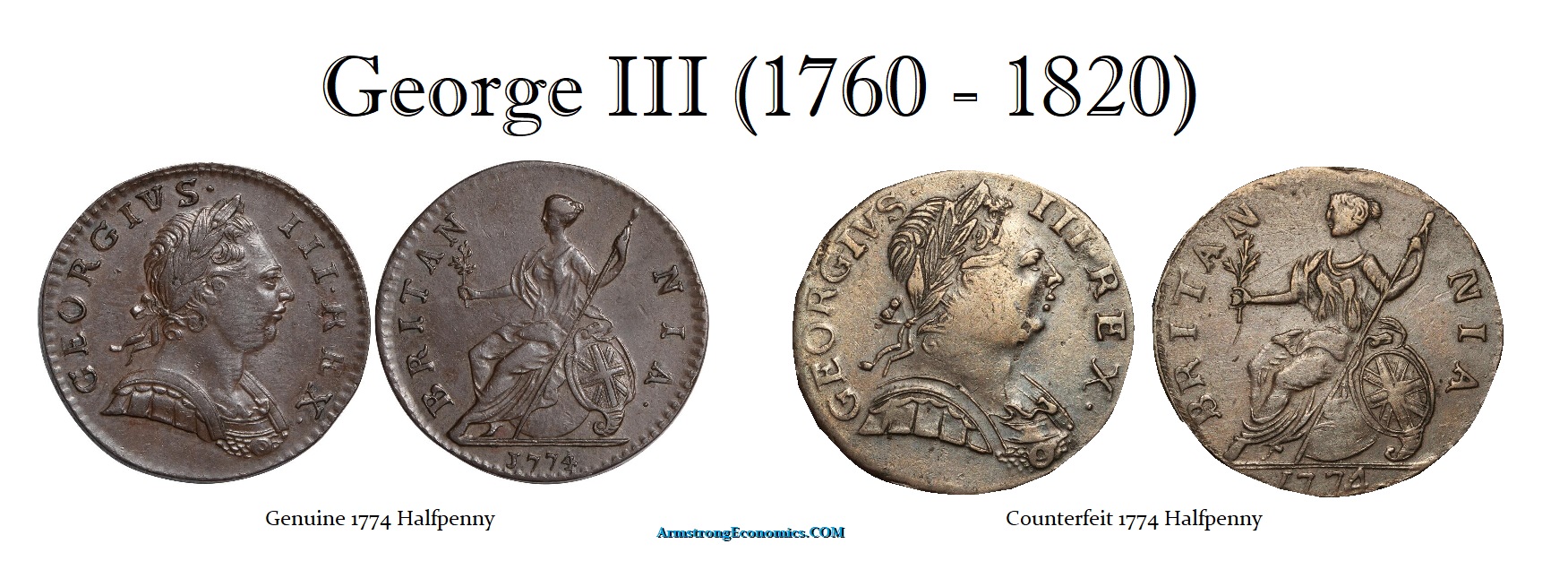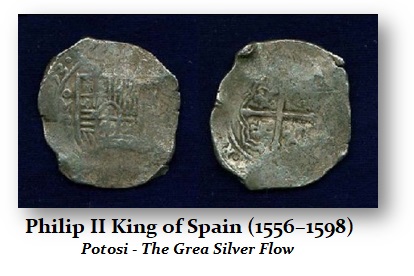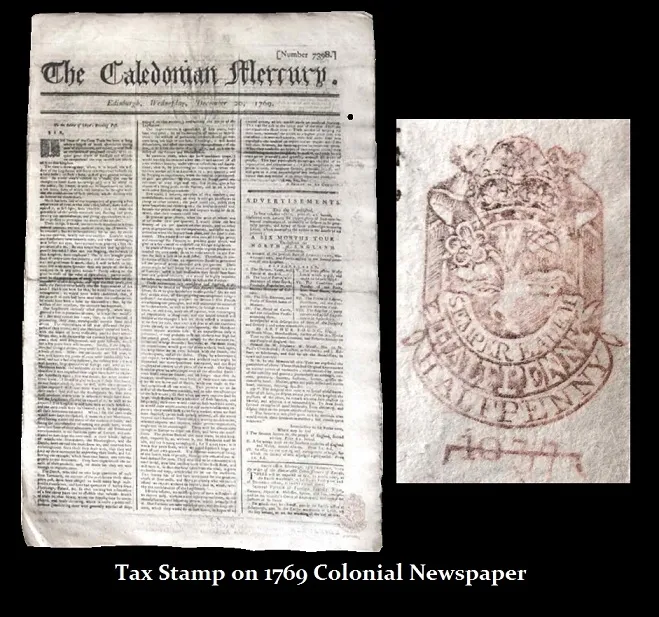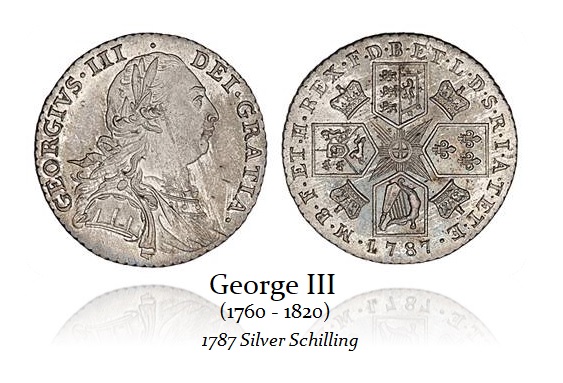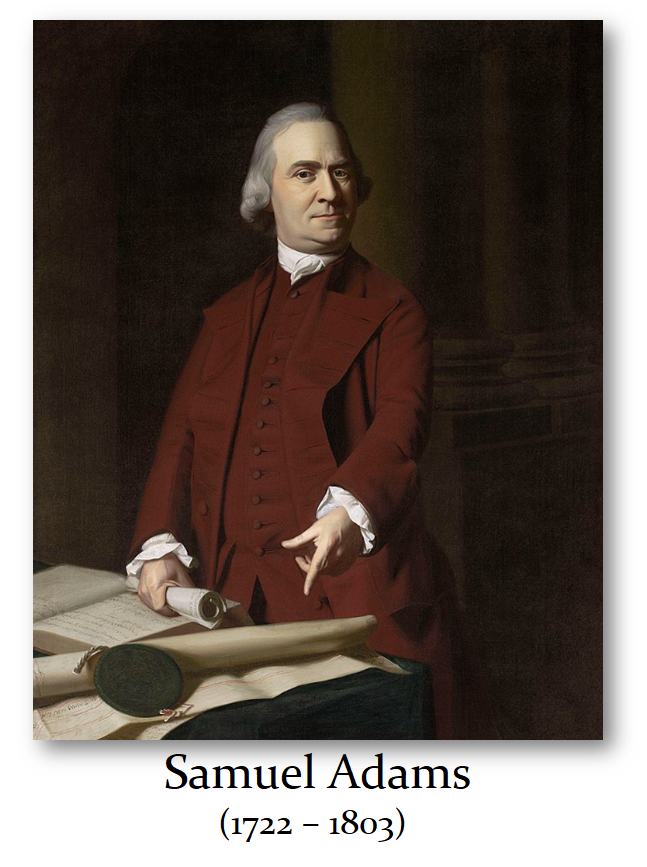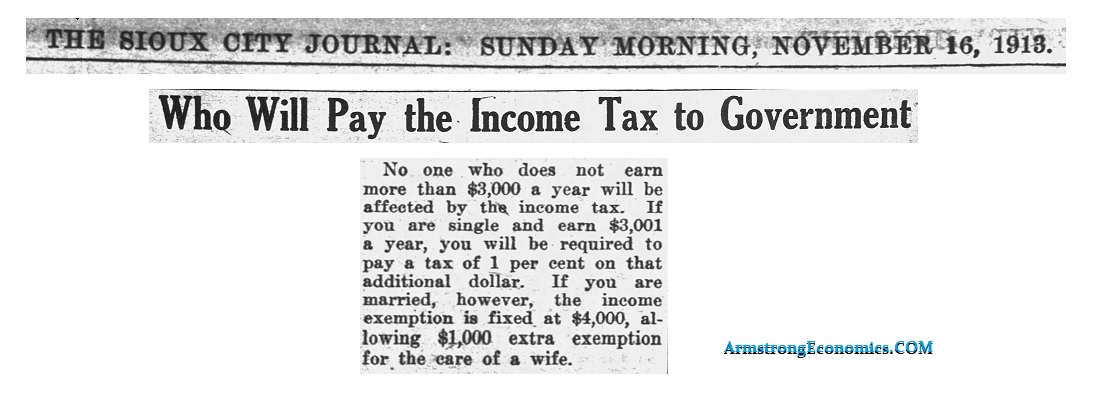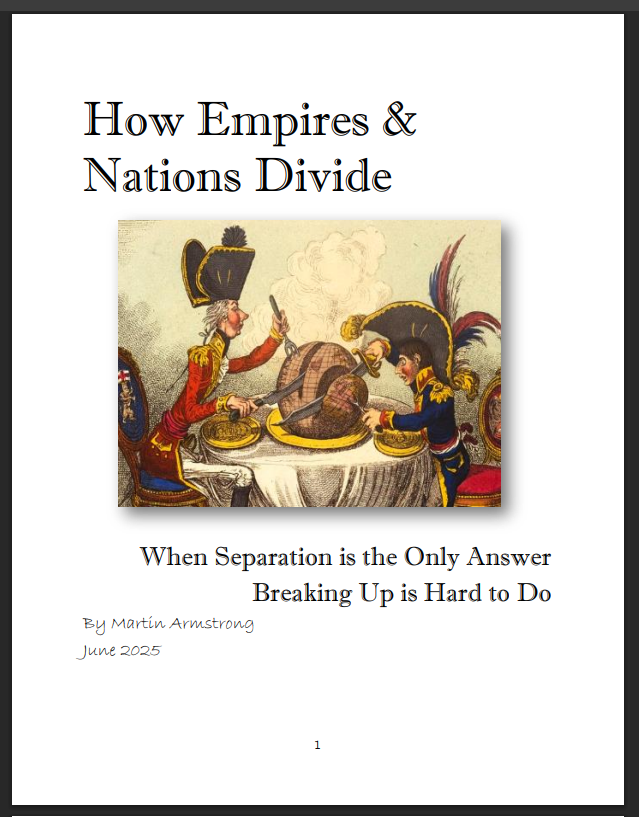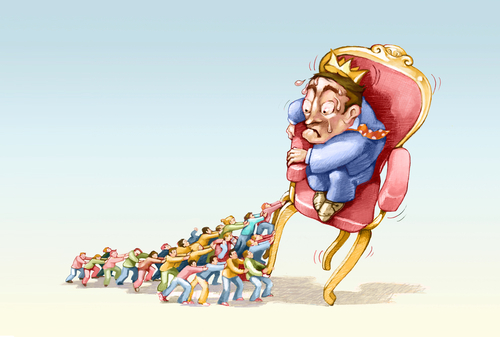I recently watched an excellent series on the History Channel, Sons of Liberty. The series starts only in 1765 and thus omits the start of the civil unrest in Boston. It needs a person to follow, so they start with Samuel Adams (1722 – 1803), a colonist who became incensed by the British Crown’s abuse of power. Nevertheless, Sam Adams dared to stand up against all odds, which eventually manifested in the American Revolution. The question of whether there will be a future revolution in history can only be answered by looking at the real causes behind the American Revolution and why there were taxes being imposed in the first place – debts from endless wars.
The series portrayed Sam Adams’ arch-enemy, John Dickinson (1732–1808), who was against independence. Some graciously considered Dickinson to be a Founding Father of the United States, but I’m afraid I have to disagree with that honor. Yes, he was a member of the First Continental Congress, where he signed the Continental Association. He also drafted most of the 1774 Petition to the King seeking redress. He then became a member of the Second Continental Congress and again wrote the 1775 Olive Branch Petition. But he was against Independence and taking up arms. He regarded Sam Adams as a troublemaker and opposed the Declaration of Independence. Dickinson abstained and/or walked out when it came to a vote. He later refused to sign the document after its passage. I do not consider him a Founding Father – sorry.
Samuel Adams is perhaps the first of the true Founding Fathers of the United States. He was the main leader of the movement that became the American Revolution and, in the end, a signer of the Declaration of Independence. It was Sam, along with John Hancock and Benjamin Franklin, who truly pushed for American Independence. Sam was a second cousin to his fellow Founding Father, President John Adams.
The series did not show the prelude to 1765 and Sam Adams’s appearance on the scene. In all honesty, it was the wars between Britain with both France and Spain that set in motion serious inflation and economically undermined the evolution of the Colonial economy. When we trace the rise of wars in North America, we come to a strange revengeful incident known as the War of Jenkins’ Ear, which perhaps started hostilities in 1731. A Spanish commander sliced off the ear of British merchant captain Robert Jenkins and told him to take it to his king, George II (1727-1760). Eventually, war broke out in 1739 between Spain and Great Britain. Britain was able to confiscate silver the Spanish were shipping home to Europe in a time of an erupting currency crisis nobody seems to really talk much about historically.
Then there was the War of the Austrian Succession (1740–1748), which challenged the legitimacy of the accession of Maria Theresa, who became the ruler of the Habsburg Dominions (1717-1780) and the Austrian throne. This war began in 1740. While initially, it did not involve either Britain or Spain directly, Britain was drawn diplomatically in 1742 like a NATO agreement as an ally of Austria against France and German Prussia.
This became known as King George’s War (1744–1748), which involved military operations in North America that were part of the War of the Austrian Succession. This war was the third of the four French and Indian Wars. It prompted a parliamentary grant of £180,000 pounds sterling to defray the expenses of 1751. Great Britain had enjoined colonial assemblies in New England from further issuing legal tender paper currency except to finance wartime deficits. Therefore, the inflation in the American Colonies was set in motion by these wars.
Britain won the Seven Years’ War in the colonies but at a tremendous cost – a Pyrrhic Victory. This was a global conflict spanning five continents. In America, it took the form of the French and Indian War (1754–1763). The French and Indian War in America was a major war fought in the American Colonies between 1754 and 1763. The British gained significant territory in North America due to the war. Finally, after years of skirmishes between England, Spain, and France in North America, this is when England officially declared war on France in 1756, unleashing the first true World War of the modern era. Simultaneously, Frederick the Great of Prussia (born 1712; ruled 1740-1786) in Europe battled against Austria, France, Russia, and Sweden.
The quarter century before the American Revolution is of special economic and historical interest with regard to colonial monetary policy. For you see, in 1749, Massachusetts dramatically ended its great inflation of nearly 827% and returned to a pure specie standard. The Seven Years’ War had a dramatic economic impact on Colonial America, reflected in the colonial paper money issue. Pennsylvania, New York, and South Carolina issued currency under a claimed (unbacked) fiduciary standard. It issued large quantities of paper money to finance the war, accompanied by only moderate increases in the rate of inflation compared to Massachusetts.
Massachusetts maintained a pure species standard to finance the war, issuing instead interest-bearing debt that curiously did not fare much better than printing money and was probably even worse than those states that just printed currency. The reason was the same crisis we have today – debt is just money that pays interest. My interpretation has been that it was worse for Massachusetts because it also raised great expectations/confidence in the government that somehow the debt was better than just printing money. That concept failed then, and it is failing today. The success of war finance in Pennsylvania, New York, and South Carolina can be attributed to paper money issues that financed government expenditures and were matched by the imposition of tax abilities for early redemption.
The resulting collapse in confidence in Massachusetts caused more significant inflation than just printing money, and this calls into question the entire Quantity Theory of Money since those states that issued more money had less inflation – not more. That theory does not hold up in the face of colonial inflation. However, modern economists do not want to look at this period for fear it would upset their theories.
Indeed, in 1750, Massachusetts issued small change notes secured by deposits of silver Spanish dollars. The Seven Years’ War (1755-1763) has a major economic impact. Pennsylvania, New York, and South Carolina each emitted over £485,000 pounds of paper currency. Still, the evidence from the behavior of prices and exchange rates reveals only mild inflation, which cannot easily be reconciled with the Quantity Theory of Money. Massachusetts, the hard-money colony, with its pure specie standard and its issue of noncirculating interest-bearing debt fared worse-than the colonies with fiduciary standards that they abused. Finally, Parliament in 1764 extended its restriction on the issue of paper money.
George III (born 1738; ruled 1760–1820) became king on October 25th, 1760. There was a currency crisis when George III came to the throne in 1760. George III faced discontent as the combination of war and inflation led to confrontations with the French and the American colonies. There were plenty of copper farthings and halfpennies, yet silver had risen in value considerably, thanks to war, which led to the hoarding of silver coinage.
During the reign of George II, his silver shillings were struck only because the British managed to seize the silver from the Spanish during the War of Jenkin’s Ear. This was silver being transported from Lima, Peru. In the first few years of George III’s reign, only one coin was minted with his portrait – the famous ‘Northumberland’ silver shilling of 1763. Only 3,000 were minted. It is believed that the mint perhaps continued to use the old dies of George II until they were worn out.
However, counterfeiting was a major problem at this period in time. In fact, the counterfeiting of the copper halfpence began soon after Charles II (1630-1685). Copper coinage was so plentiful that production was even halted at the request of merchants. There were simply more counterfeits in circulation than official mint issues. The laws were strengthened to deal more severely with copper counterfeits but had little effect since they applied only when the forged coin was an exact copy of the official issue. The counterfeiters got around this by changing the bust styles, and some of them changed the legends on the coins to skirt the law. Most of these counterfeits were lightweight. Finally, in 1771, the Royal Mint was directed to produce full-weight copper coins, which they hoped would be more desirable than the lightweight forgeries. The Royal Mint began producing farthings and halfpennies with George III busts. As shown here, counterfeits were still being produced. They would melt down the genuine coins and produce lighter-weighing counterfeits.
About 200 years before, this marked the Great Silver Flow that altered the monetary system of Europe from the Potosí silver mine in Bolivia. (see Potosi: The Silver City That Changed the World: By Kris Lane). This took place during the reign of Philip II, King of Spain (1556–98). This was what made the Spanish 8 reales into the new dominant currency in the world. Even China adopted this as their new silver standard, and these Spanish coins became the alternative to British pounds, so much so that when the US dollar was created, it was based upon these Spanish 8 reals that became known as dollars.
The Stamp Act 1765 (5 Geo. 3. c. 12) was an Act of the Parliament of Great Britain that imposed a direct tax on the British colonies in America and required that many printed materials in the colonies be produced on stamped paper from London which included an embossed revenue stamp. This is what began the movement “No Taxation Without Representation.” This series appears to begin with this direct taxation on American Colonies that applied to freedom of the press. This was the first internal tax levied directly on American colonists by the British Parliament. Britain was deeply in debt because of the Seven Years’ War (1756-1763), which was truly the first World War of the modern era.
The American colonists argued that only their own representative assemblies could tax them. The colonists insisted that the act was unconstitutional, and they resorted to mob violence to intimidate stamp collectors into resigning. Parliament had passed the Stamp Act on March 22, 1765 and was eventually forced to repeal it in 1766. They then issued a Declaratory Act at the same time to reaffirm its authority to pass any colonial legislation it saw fit. The issues of taxation and representation raised by the Stamp Act strained relations with the colonies to the point that, 10 years later, the colonists rose in armed rebellion against the British. The scheme was to extract silver and gold from the colonies, but any payment to the colonies was to be in copper. This was all thanks to the cost of war.
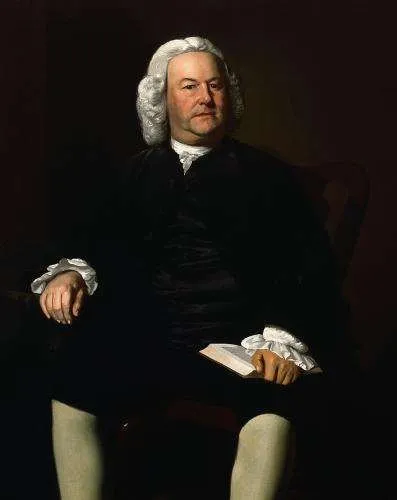 There was a legal case that became the seminal beginning of the American Revolution known as Entick v. Carrington and Three Other King’s Messengers (1765), reported at length in 19 Howell’s State Trials 1029. This case was the start of the American Revolution and was also based upon abuse of the king’s agents. The action, dated November 1762, was for trespassing and interfering with the plaintiff’s dwelling by breaking open his desks and boxes and searching and examining his papers.
There was a legal case that became the seminal beginning of the American Revolution known as Entick v. Carrington and Three Other King’s Messengers (1765), reported at length in 19 Howell’s State Trials 1029. This case was the start of the American Revolution and was also based upon abuse of the king’s agents. The action, dated November 1762, was for trespassing and interfering with the plaintiff’s dwelling by breaking open his desks and boxes and searching and examining his papers.
After George III became king in 1760, by February 1761, Parliament enacted the Writs of Assistance that was challenged in court in Boston, Massachusetts. These were writs that empowered the king’s agents to search anything they suspected, like the NSA today at their discretion. The defending lawyer James Otis (1725-1783) pronounced these writs as “the worst instrument of arbitrary power, the most destructive of English liberty, and the fundamental principles of law, that ever was found in an English law book.” Otis warned that the king placed discretion in the hands of every agent to act as he desired. Nothing has changed, for our current government can do whatever it desires today, and it is always the burden of the citizen to prove he has any rights whatsoever.
John Adams (1735–1826; 2nd President 1797–1801) was in the audience at that hearing that day, and the four-hour speech of James Otis so moved him that he declared:
“Then and there was the first scene of the first act of opposition to the arbitrary claims of Great Britain. Then and there, the child independence was born.”
I am sure the king’s men also viewed their power as necessary, as the government does today. The abuse of the king’s agents was simply that they could enter someone’s home and search all their papers. If you wrote anything derogatory against the king, off you went to prison. This is what inspired the Fourth Amendment, which stated that there had to be a reason to search, not just an arbitrary desire to see what we could find. This is the very essence of LIBERTY. You cannot pretend to be the leader of the free world and then advocate that the government has a RIGHT to know everything everyone is doing or what wealth they have. This is incompatible with the term “FREEDOM.”
In 1768, the Townshend Acts were enacted in the Thirteen Colonies, placing tariffs on a variety of common items that were manufactured in Britain and imported in the colonies. Colonists objected that the Acts were a violation of their rights. The Massachusetts House of Representatives sent a petition complaining and asking King George III to repeal the Act. The Boston colonists called for a boycott of merchants importing the affected goods. This is not explained in the TV series but you do see the boycott.
The Boston Massacre is depicted in the series but only partially. This was a confrontation in Boston on March 5th, 1770, in which nine British soldiers were being harassed by several hundred colonists throwing stones and snowballs at them. They responded by shooting several of a crowd, wounding some and killing a few. This event was heavily publicized as “a massacre” by leading Patriots such as Paul Revere and Samuel Adams. Here is Henry Pelham’s engraving that served as the basis for Paul Revere’s engraving, The Bloody Massacre, depicting the Boston Massacre
On March 27, the eight soldiers, Captain Preston, and four civilians were indicted for murder; the civilians were in the Customs House and were alleged to have fired shots.
Also omitted from the series was that the trial of the soldiers took place, and their lawyer was John Adams. It was his defense of the soldiers was clever. But he really stacked the jury with pro-British supporters. His argument regarding jury decisions has been remembered:
“Facts are stubborn things; and whatever may be our wishes, our inclinations, or the dictates of our passion, they cannot alter the state of facts and evidence.”
Adams won an acquittal for six of the soldiers. Two, who had fired directly into the crowd, were convicted of manslaughter. Adams was paid a small sum by his clients.
Consequently, by the late 18th century, there was such a shortage of silver that this in part contributed to the American Revolution. Silver was too expensive to mint current coins. Silver shillings coins were not produced after 1763 until 1787. The American colonists began using Spanish 8 reals, which they called a dollar, having no alternative. By 1787, only 7% of circulating coins in Britain were genuine. The cost of war had a profound economic impact on Britain. What fueled the American Revolution was the fact that this tax was to be paid only in gold or silver. Anything the Colonies sold to Britain was paid in copper. In order to discourage smuggling and bribery, Parliament decided to make paper money illegal. If anyone was found guilty of breaking the laws, the fines had to be paid in gold or silver. These measures, in the face of a shortage of silver and gold, combined with the lack of paper money, fueled inflation in the colonies.
The question of whether there will be a future revolution in history will be answered with a resounding YES. There is never a question of IF but only when for those in power will always abuse that power when they know they are losing it. It was the fiscal mismanagement of war that created the currency crisis that eventually fueled the American Revolution. Kamala Harris’s proposing a 44.6% tax on capital gains is always marketed at the rich. However, it will apply when you sell your home and seek to retire, move, or just downsize after the kids are gone.
They will always say they are after the rich, but in truth, it always comes down to the middle class, which represents the bulk of the economy. If they confiscated all the wealth of the billionaires, that would not cover the interest expenditures for one year. They never consider that they are the problem. They always look upon the people as the problem. We are still paying interest on the debt for World War II because they never pay off the debt but only add to it every year. Up to 70% of the interest is exported to holders of US debt like China and Japan.
As the Neocons scheme for yet another war that they borrow to fund endlessly, they do not care about the country, our future, or the people. All they care about is their own personal desire to dominate the world. Perhaps there will be the modern version of Sam Adams, who suddenly becomes offended by the endless abuse. The $5 trillion tax hikes proposed by Kamala may be the catalyst that sparks the revolution, just as the Stamp Act did in 1765. They never consider spending less. It is always just getting more from We the People.


